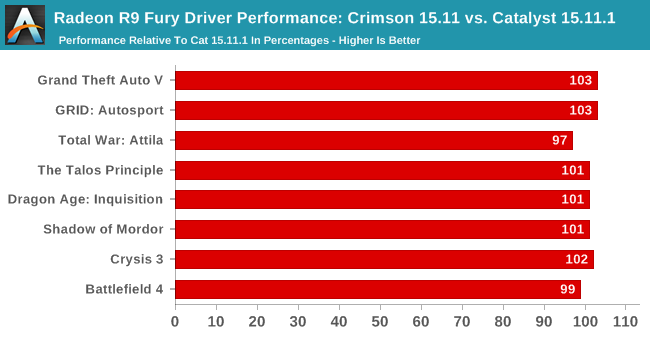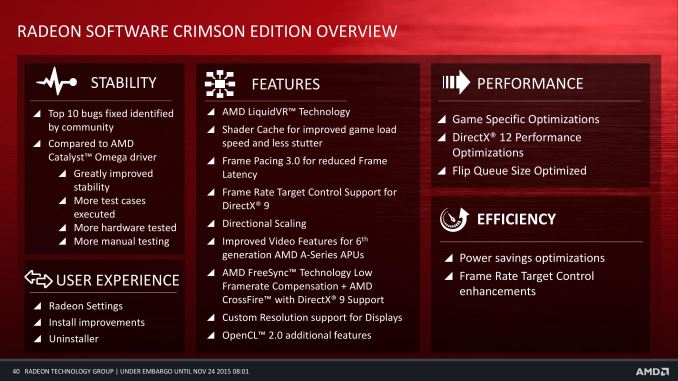AMD's Radeon Software Crimson Driver Released: New Features & A New Look
by Ryan Smith & Daniel Williams on November 24, 2015 8:00 AM ESTCrimson Performance
Last but certainly not least, let’s talk about performance improvements. Like the Omega driver before it, Crimson comes with a collection of performance improvements from AMD’s new driver branch. To preface this with caution, I don’t think anyone should be expecting massive system-wide performance gains – that’s all low-hanging fruit AMD picked long ago – but there’s plenty of room for some lesser optimizations along with game-specific optimizations.
AMD’s own numbers point to game-specific improvements of up to 20%, though it should be noted that AMD’s best-case numbers are on unreleased/beta games that have yet to be well-optimized in the first place. Otherwise AMD’s own numbers are far more tame, listing recently released games with gains between three and five percent.
To take a quick look at general performance, we went ahead and ran our GPU benchmark suite at 2560x1440 on our Radeon R9 Fury (vanilla), comparing the previous Catalyst 15.11.1 beta to the new Radeon Software Crimson 15.11 beta. The Fury and its underlying Fiji GPU is the newest product out of AMD, so it offers AMD the best opportunity to unlock any remaining performance in the architecture.

Overall the average performance gain at 2560x1440 is just 1%. There are a couple of instances where there are small-but-consistent performance gains – Grand Theft Auto V and Grid: Autosport stand out here – but otherwise the performance in our other games is within the margin of error, plus or minus. Not that we were expecting anything different as this never was pitched as a golden driver, but this does make it clear that more significant performance gains are going be on a per-game basis.
Final Thoughts
Wrapping things up, AMD’s development structure in the past year and going forward is one that has both been beneficial to the company and has brought with it its own drawbacks. By focusing feature releases around the end of the year driver, AMD is able to cut down on what parts of the driver they change (and thereby can possibly break) at other times of the year, and try to knock out all of their feature-related bugs at once. At the same time it makes the annual driver release a significant event, as AMD releases a number of new features all at once. However on the other hand this means that AMD has few features launching any other time of the year, which can make it look like they’re not heavily invested in feature development at those points. Then of course there’s the WHQL element, where for multiple reasons AMD hasn’t issued very many WHQL releases this year, and is something they’re seeking to change in 2016.
Looking under the hood there’s no single feature that’s going to blow every Radeon user away at once, but overall there are a number of neat features here that should be welcomed by various user groups. The Freesync Low Framerate Compensation changes should be of particular interest to Freesync users, while shader caching will improve shader loading performance across the board. Otherwise smaller fixes like the DirectX 9 improvements to CrossFire frame pacing, CrossFire Freesync, and framerate target control should be welcome news to APU and dual graphics users.
Meanwhile AMD’s radical overhaul of their control panel via the new Radeon Settings application will be quickly noticed by everyone. Though there’s plenty of room for interpretation on style and just how a good control panel is laid out, AMD has clearly put a lot of effort into cleaning up the layout of their control panel and it shows, as important options are no longer buried under multiple layers of menu trees. And on the performance front Radeon Settings is faster than Catalyst Control Center even on fast machines, and though we haven’t spent much time on covering it, AMD has also managed to speed up the installation process while they were at it. So all-told the Crimson release has something for everyone.
Ultimately I hesitate to ascribe too much of this to the Radeon Technologies Group too soon – this project has clearly been in the works longer than 3 months – but at the same time this is the RTG making their mark. It’s a new direction for AMD’s graphics group and a new look to match. And if the RTG can meet their stability, performance, and release goals going forward with the new Crimson driver, then they should be able to make 2016 a good year for the Radeon user base.


















146 Comments
View All Comments
zeeBomb - Tuesday, November 24, 2015 - link
Woo awesome! Great rundown Daniel and Ryan!Samus - Wednesday, November 25, 2015 - link
Totally. Props on covering this, it's about time AMD brought their A-game to NVidia so they can stop using their drivers as a crutch.Dalamar6 - Thursday, November 26, 2015 - link
Click Display -> additional settings > cringe and wish you didn't just shill there.Literally just a metro style frontend for the old CCC.
Oxford Guy - Thursday, November 26, 2015 - link
And how frequently does anyone do that? You still get multiple styles in Windows 10, btw.Chaitanya - Tuesday, November 24, 2015 - link
Thanks for the review, looks like finally AMD has paid attention to drivers of its graphics hardware.Zeus Hai - Tuesday, November 24, 2015 - link
It's a joke they still dont even have Adaptive V-sync. I have overclocked my Monitor for years, and Adaptive Vsync has always been the killer feature for me.Everything AMD chosed to ignore in a fight with Intel or Nvidia always hit them extremely hard in the end.
Glenn37216 - Tuesday, November 24, 2015 - link
Yup , Also you still cant run borderless windows in Crossfirein Direct X titles. With SLI you can ...Mantle is the only exception but what a failure that tech is ..its beyond comprehension.
looncraz - Tuesday, November 24, 2015 - link
I wouldn't call Mantle a failure, there are several games out there that use it to great effect (I prefer it in BF4 over DX11), it helped to push DX12 into a desirable direction, and it is being turned into the Vulcan API.AMD accomplished what they wanted from it, and they no longer need to put resources into it since everyone else is doing it for them.
Samus - Wednesday, November 25, 2015 - link
Honestly, Mantle in BF4 is a joke. There are lots of rendering issues, erratic performance/minimum framerate drops, and the lingering VRAM crashes on cards with 2GB or less, like my R9 380. I would have gone for 4GB, but 4GB is ridiculous for 1080P.nagi603 - Wednesday, November 25, 2015 - link
Pray tell why 4GB is ridiculous for 1080p. There aren't many AAA-games that use less than 2GB VRAM on 1080p on my 290X.